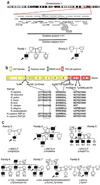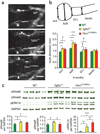Loss-of-function mutations in TGFB2 cause a syndromic presentation of thoracic aortic aneurysm
- PMID: 22772368
- PMCID: PMC3616632
- DOI: 10.1038/ng.2349
Loss-of-function mutations in TGFB2 cause a syndromic presentation of thoracic aortic aneurysm
Abstract
Loeys-Dietz syndrome (LDS) associates with a tissue signature for high transforming growth factor (TGF)-β signaling but is often caused by heterozygous mutations in genes encoding positive effectors of TGF-β signaling, including either subunit of the TGF-β receptor or SMAD3, thereby engendering controversy regarding the mechanism of disease. Here, we report heterozygous mutations or deletions in the gene encoding the TGF-β2 ligand for a phenotype within the LDS spectrum and show upregulation of TGF-β signaling in aortic tissue from affected individuals. Furthermore, haploinsufficient Tgfb2(+/-) mice have aortic root aneurysm and biochemical evidence of increased canonical and noncanonical TGF-β signaling. Mice that harbor both a mutant Marfan syndrome (MFS) allele (Fbn1(C1039G/+)) and Tgfb2 haploinsufficiency show increased TGF-β signaling and phenotypic worsening in association with normalization of TGF-β2 expression and high expression of TGF-β1. Taken together, these data support the hypothesis that compensatory autocrine and/or paracrine events contribute to the pathogenesis of TGF-β-mediated vasculopathies.
Figures





Comment in
-
Transforming growth factor β2 mutations and familial thoracic aortic aneurysms.Circ Cardiovasc Genet. 2012 Oct 1;5(5):593-4. doi: 10.1161/CIRCGENETICS.112.964858. Circ Cardiovasc Genet. 2012. PMID: 23074340 No abstract available.
References
-
- Moustakas A, Heldin CH. The regulation of TGFbeta signal transduction. Development. 2009;136:3699–3714. - PubMed
-
- Rahimi RA, Leof EB. TGF-beta signaling: a tale of two responses. J Cell Biochem. 2007;102:593–608. - PubMed
-
- Dietz HC, et al. Marfan syndrome caused by a recurrent de novo missense mutation in the fibrillin gene. Nature. 1991;352:337–339. - PubMed
-
- Isogai Z, et al. Latent transforming growth factor beta-binding protein 1 interacts with fibrillin and is a microfibril-associated protein. J Biol Chem. 2003;278:2750–2757. - PubMed
Publication types
MeSH terms
Substances
Grants and funding
- U54 HG006542/HG/NHGRI NIH HHS/United States
- 5RC1HL100021-02/HL/NHLBI NIH HHS/United States
- 1U54HG006542/HG/NHGRI NIH HHS/United States
- K08 HL107738/HL/NHLBI NIH HHS/United States
- P01-AR049698/AR/NIAMS NIH HHS/United States
- HHMI/Howard Hughes Medical Institute/United States
- HL107738-01/HL/NHLBI NIH HHS/United States
- R01 AR041135/AR/NIAMS NIH HHS/United States
- RC1 HL100021/HL/NHLBI NIH HHS/United States
- P01 AR049698/AR/NIAMS NIH HHS/United States
- R01- AR41135/AR/NIAMS NIH HHS/United States
- 1U54RR023561-01A1/RR/NCRR NIH HHS/United States
LinkOut - more resources
Full Text Sources
Other Literature Sources
Medical
Molecular Biology Databases

